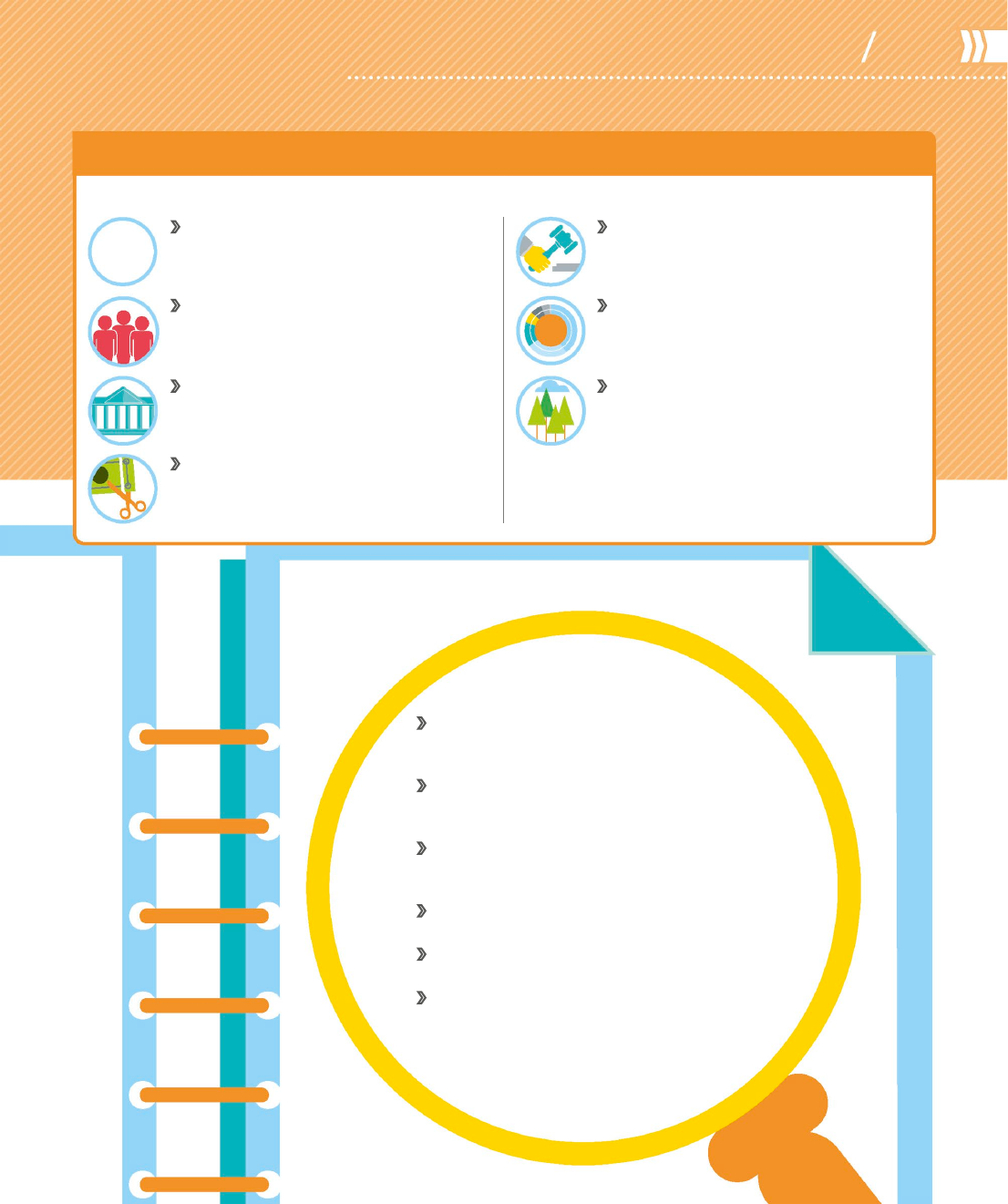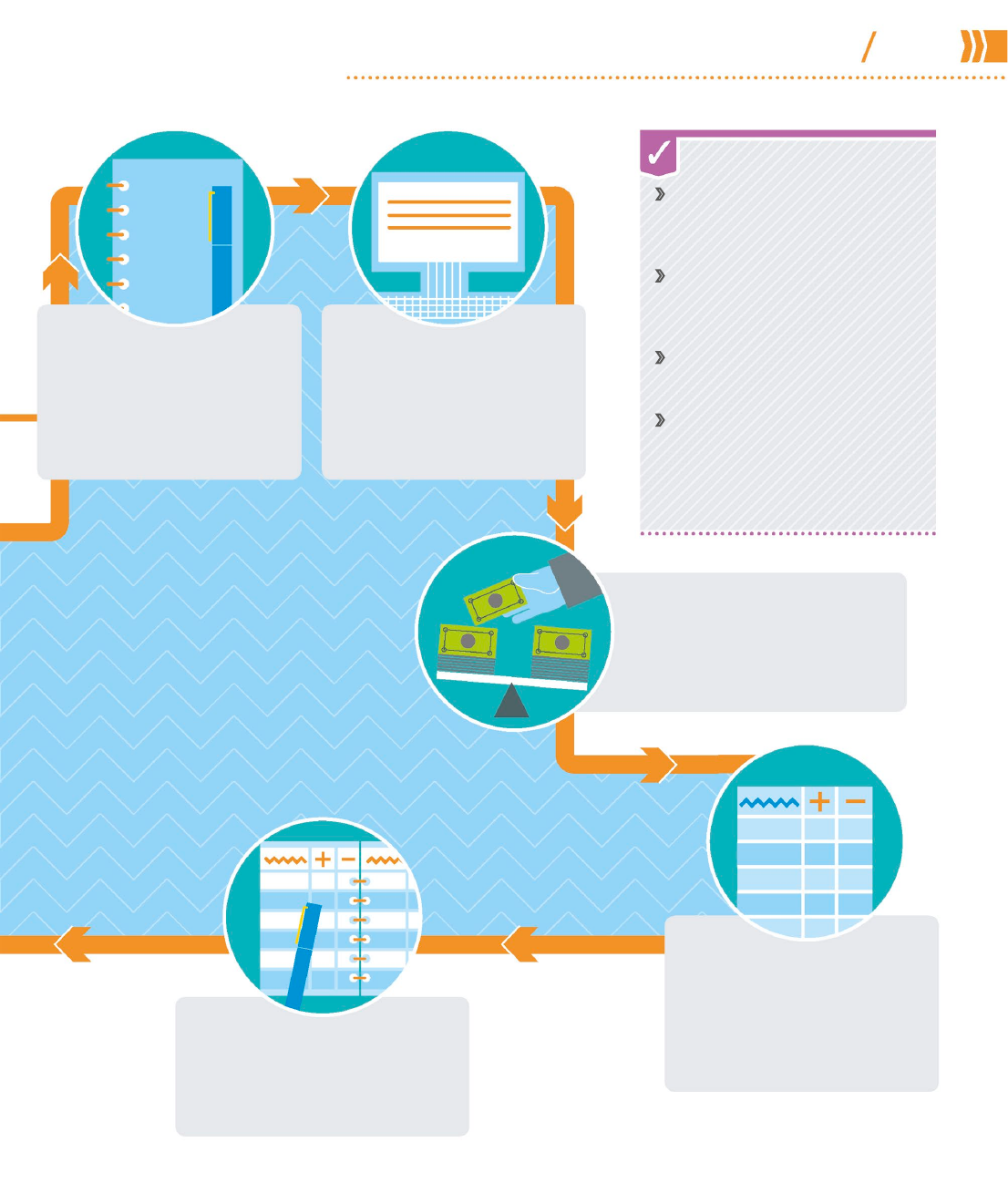
Financial
reporting
$50
billion
the amount hidden via
loans diguised as sales by
Lehman Brothers in 2008
Financial reports are everywhere: a bill at a restaurant is a financial report, as
are sales receipts and bank statements. In business, however, financial reporting
refers to the financial statements that make up a company’s annual report and
accounts. Compiled by accountants, they provide investors and lenders with
information to assess a company’s profitability, and enable company managers,
government, tax authorities, and other stakeholders to evaluate the business.
Types of financial reports
Financial reports take many forms and can
contain a vast amount of information about a
company’s finances, work, core business values,
performance, employees, and its compliance
with local, logistical, domestic, and international
laws. The most important financial report,
or statement, is usually the annual report—
essentially a collection of many other, smaller
reports—which sums up how the business has
performed in the last year. There is a multitude
of laws, regulations, and guidelines governing
what should be put into this report.
The annual report
Financial statements usually appear in a company’s
annual report and sum up its financial activities in a
standardized way for different audiences to interpret
quickly and clearly. These statements take diverse forms,
and being able to deconstruct them is a vital skill for
accountants and businesspeople, making it simple
to see how well a business is performing and why.
The eight steps of the accounting cycle are
used by nearly all accountants. The cycle
helps by standardizing processes and makes
sure that accounting jobs are
performed correctly and in
the same way and order
for every activity.
See pp.102–103.
THE ACCOUNTING CYCLE
$
$
$
US_100-101_Financial_Reporting_overview.indd 100 21/11/2014 16:23

100 101
HOW FINANCE WORKS
Financial reporting
There are seven widely recognized types of accounting:
Types of accounTing
F
i
n
a
n
c
i
a
l
s
t
a
t
e
m
e
n
t
s
What’s in an annual report? A full record
of company performance according to various
criteria, as well as accounts. See pp.104–105.
What are the statements? The main one is
financial; others include sustainability, directors’
pay, and charitable donations. See pp.106–107.
Who reads which statements? Sections are
relevant to banks, shareholders, government,
auditors, staff, and media. See pp.108–109.
What do the notes mean? Main statements
are annotated in detail. See pp.104–109.
What are the rules? Accounting principles
regulate financial reports. See pp.112–113.
Which are the most important financial
statements? Profit-and-loss statements,
balance sheets, and cash-flow statements
contain key facts. See pp.114–121.
Financial Drawn up by accountants;
used by investors, creditors, and
management. See pp.110–129.
Management Used by managers
to control cash flow and budgets, and
forecast sales. See pp.130–143.
Governmental Also called public
finance accounting; used by public
sector for noncommercial accounting.
Tax Dictates exact rules that companies
and individuals must follow when
preparing and submitting tax returns.
Forensic Engages in disputes and
litigation, and in criminal investigations
of fraud. See pp.152–153.
Project Deals with a particular project;
a useful aid for project management.
Social and environmental Shows how
a company makes a positive difference
to the community and environment.
$
$
$
US_100-101_Financial_Reporting_overview.indd 101 15/12/2014 12:56

How it works
The cycle works as an aid to organize workflow into a
cyclical chain of steps that are designed to reflect the
way assets, money, and debts have moved in and out
of a business. It progresses through eight different
steps, in the same order each time, and restarts as
soon as it has finished. The cycle can be based on
any length of time—this is known as an accounting
period—and usually lasts a month, a quarter, or a year.
Accounts which deal with revenues and expenses
return to zero at the end of each financial year, while
accounts showing assets, liabilities, and capital carry
over from year to year.
The accounting cycle
The eight-step cycle
The processes shown here are
repeated in the same way for every
accounting period. All businesses
go through different phases, and the
accounting cycle works by reflecting
that. The financial statement, which
is prepared toward the end of each
cycle, is helpful in showing how
strongly the business has performed
during each period of time.
The accounting cycle is a step-by-step process bookkeepers use to
record, organize, and classify a company’s financial transactions.
It helps to keep all accounting uniform and eliminate mistakes.
Internal controls A method
of deploying, measuring, and
monitoring a business’s resources.
This helps prevent fraud and keep
track of the value of assets.
Double-entry bookkeeping
The process of recording all
transactions twice—as a debit
and as a credit. If a company buys
a chair for $100, its debit account
increases by $100 and its credit
account decreases by $100.
Bad debts Debts that cannot be
or are unlikely to be recovered, so
are useless to the creditor (lender),
who writes them off as an expense.
Financial statements
The corrected balances are then
used to prepare the company’s
financial statements.
Closing the books
A closing entry based on adjusted
journal entries is taken, the books
are closed, and the cycle restarts.
Transactions
Any type of financial transaction,
from buying or selling an asset to
paying off a debt, can start the
accounting cycle.
BOOKKEEPING AND
ACCOUNTING
new cycle
6,000
15,000
21,000
US_102-103_The_Accounting_Cycle.indd 102 21/11/2014 16:23
102 103
HOW FINANCE WORKS
Financial reporting
13%
more accountants
will be required
in the US by 2022
Debits An entry where assets and
expenses increase. In double-entry
accounting, debits appear on the
left-hand side of the account
Credits An entry where revenue,
owners’ equity, and liabilities increase.
In double-entry accounting, credits
appear on the right-hand side
Chart of accounts List giving
the names of all of a company’s
accounts, used to organize records
Audit trail Full history of a
transaction, allowing auditors to
trace it from its source, through
the general ledger, and note any
adjustments made
NEED TO KNOW
Journal entries
Accountants then analyze the
transaction and note it in the
relevant journal—a book or an
electronic record.
Posting
Journal entries are then
transferred to thegeneral
ledger—a large book or
electronic record logging
all the company’s accounts.
Worksheet
Often, trial balance calculations
don’t accurately balance the
books (see pp.116–117). In such
cases, changes are made on
a worksheet.
Adjusting journal entries
Once the accounts are balanced, any
adjustments are noted in journals at
the end of the accounting period.
Trial balance
A list of all the company’s accounts
is prepared at the end of the
accounting period, usually a year,
quarter, or month.
10,000
21,000
23055
$
$
$
US_102-103_The_Accounting_Cycle.indd 103 09/11/2016 11:01

102 103
HOW FINANCE WORKS
Financial reporting
13%
more accountants
will be required
in the US by 2022
Debits An entry where assets and
expenses increase. In double-entry
accounting, debits appear on the
left-hand side of the account
Credits An entry where revenue,
owners’ equity, and liabilities increase.
In double-entry accounting, credits
appear on the right-hand side
Chart of accounts List giving
the names of all of a company’s
accounts, used to organize records
Audit trail Full history of a
transaction, allowing auditors to
trace it from its source, through
the general ledger, and note any
adjustments made
NEED TO KNOW
Journal entries
Accountants then analyze the
transaction and note it in the
relevant journal—a book or an
electronic record.
Posting
Journal entries are then
transferred to thegeneral
ledger—a large book or
electronic record logging
all the company’s accounts.
Worksheet
Often, trial balance calculations
don’t accurately balance the
books (see pp.116–117). In such
cases, changes are made on
a worksheet.
Adjusting journal entries
Once the accounts are balanced, any
adjustments are noted in journals at
the end of the accounting period.
Trial balance
A list of all the company’s accounts
is prepared at the end of the
accounting period, usually a year,
quarter, or month.
10,000
21,000
23055
$
$
$
US_102-103_The_Accounting_Cycle.indd 103 09/11/2016 11:01

How it works
Financial statements summarize a company’s
commercial activities clearly and succinctly, with
details of the business’s performance and changes to
its financial position. They are aimed at several parties,
so they need to be detailed but also comprehensible
to the general public. The statements are usually
presented together in the form of an annual report,
with in-depth accounts and footnotes to give detail.
Legal requirements vary, but accounts must be exact.
Financial statements
The formal records of a business’s financial activities are presented as
financial statements. Most jurisdictions require accurate information
by law, and financial directors and auditors are liable for its contents.
What’s in an annual report
The contents page shows where to find the big three statements—the balance sheet, cash-flow
statement, and profit-and-loss statement—and softer information such as stories about staff and
opinions of other stakeholders. The annual report provides an opportunity to impress shareholders
and lenders as well as fulfill legal reporting obligations. It will contain all, or most, of the following.
It is common for the chairman
to write an introduction
focusing on the positives and
explaining any negative parts
of an annual report for the
benefit of shareholders.
C
h
a
i
r
’
s
i
n
t
r
o
d
u
c
t
i
o
n
This section underlines a
company’s social ethos, in
particular its community
involvement. Different types
of companies may focus on
different values.
O
u
r
c
u
s
t
o
m
e
r
s
a
n
d
c
o
m
m
u
n
i
t
y
A brief overview summarizes
the key areas of finance
for the company, including
overall performance,
turnover, operating
costs, capital investment,
depreciation, interest charges,
taxation, and dividends.
(See also pp.114–121.)
O
u
r
fi
n
a
n
c
e
s
These pages contain much of
the company’s information on
its environmental protocols,
most of which are industry-
specific. See also pp.122–123.
O
u
r
e
n
v
i
r
o
n
m
e
n
t
A section on employees
details areas such as staff
development and training,
health and safety, and key
statistics on staff satisfaction.
O
u
r
e
m
p
l
o
y
e
e
s
The infrastructure pages of
an annual report are a good
place to supply more detail
about the company’s fixed
assets and explain why the
company is an attractive
investment for investors
O
u
r
i
n
f
r
a
s
t
r
u
c
t
u
r
e
$
US_104-109_Financial_Statements.indd 104 21/11/2014 17:27
104 105
How finance works
Financial reporting
Performance indicators are
common across all industries.
They measure areas such as
customer satisfaction and the
quality of goods or services
provided by the company.
O
u
r
p
e
r
f
o
r
m
a
n
c
e
i
n
d
i
c
a
t
o
r
s
The environmental
accounting section contains
figures that pertain to the
environment, often those
stipulated by law—for
example, greenhouse
gas emissions.
E
n
v
i
r
o
n
m
e
n
t
a
l
a
c
c
o
u
n
t
i
n
g
The board of directors,
governance report, and
statement of directors’
responsibilities sections
indicate who is leading the
company, showcases their
credentials and roles, and
reveals their pay.
B
o
a
r
d
o
f
d
i
r
e
c
t
o
r
s
In the directors’ report,
members of the board
of directors give their
professional opinions
on how the business
has performed over
the last year.
D
i
r
e
c
t
o
r
s
’
r
e
p
o
r
t
Auditors are independent
and check the accuracy of
companies’ accounts. This
helps to eliminate mistakes
and track fraud.
I
n
d
e
p
e
n
d
e
n
t
a
u
d
i
t
o
r
’
s
r
e
p
o
r
t
Notes to the accounts
are a key part of financial
statements. They provide
extra detail, insight, and
explanation of the bare-
bones figures supplied in
earlier pages of the report.
N
o
t
e
s
t
o
t
h
e
a
c
c
o
u
n
t
s
CO
2
In an era of globalization, large corporations are now commonly made up of
multiple companies. Companies owned by a parent company are known as
subsidiaries, and continue to maintain their own accounting records, but the
parent company produces a consolidated financial statement, which shows
the financial operations of both companies. Depending on the jurisdiction’s
reporting requirements, however, if a company owns a minority stake in a
second company, then the latter will not be included in the former’s
consolidated financial statement.
COnsOlidated finanCial statements
need tO knOw
Subsidiary One company that
is controlled by another, usually
a holding company
Holding company A company
set up to buy shares of other
companies, then control them
Globalization The process of
businesses developing such large
multinational presences that they
transcend international borders
$
US_104-109_Financial_Statements.indd 105 21/11/2014 17:27
..................Content has been hidden....................
You can't read the all page of ebook, please click here login for view all page.
